With an average daily temperature of 70.7°F, Florida is the warmest state in the entire mainland U.S. This sunny climate has attracted over 500 species of bird since records began, and more than 20 of them are types of sparrows.
But the sheer variety of species doesn’t mean that Florida is ideal sparrow country. The state’s 21 million human population has had a big impact on the local ecology, and many species are now much rarer than they were decades ago.
Because many sparrow species rely on wetlands and wildflower meadows to thrive, this family of birds has been hit hard by agricultural and urban development that has undervalued these vital wildlife habitats.
While you can help support several species of sparrows by offering them food from your backyard bird feeder, the key to the population’s recovery will be the restoration of their natural habitats.
Our list of sparrows in Florida includes one of the rarest subspecies of any bird in the USA. Kudos to anyone who can guess which that is!
22 Sparrows in Florida, Starting With the Most Common
Eastern Towhee

- Pipilo erythrophthalmus
- Length: 6.5-8.2 in
- Weight: 1.1-1.9 oz
- Wingspan: 7.9-11.0 in
Although not everyone would think of towhees as sparrows, they are very much a part of the New World sparrow family. The rusty red flanks and white chest of these beautiful birds stand out in striking contrast to their darker heads and backs, which are black in males and beige in females.
Eastern Towhees are the most frequently seen sparrow in Florida during the summer when many other sparrows migrate north. They are one of the most common sparrows in Florida during the winter too.
Eastern Towhees are common birds in overgrown backyards, as they love rummaging through thick shrubs and weedy brush. They’ll also come to visit backyard bird feeders, usually hopping around on the ground to clean up the spillover from other birds.
House Sparrow

- Scientific Name: Passer domesticus
- Length: 5.9-6.7 in (15-17 cm)
- Weight: 0.9-1.1 oz (27-30 g)
- Wingspan: 7.5-9.8 in (19-25 cm)
House sparrows are not native to the US and were introduced to New York City in 1852 from Europe. They quickly spread and now can be found throughout the USA and Southern Canada. Their presence sometimes concerns ornithologists, since these territorial birds can sometimes dominate the nesting grounds of native species.
Because they’re not related to native sparrows, house sparrows behave quite differently. They don’t migrate and tend to stick to the same territories throughout the year. Although they’re not as common here as in more northerly states, house sparrows are still a fairly regular sight in Florida.
Flocks of house sparrows are regular visitors to bird tables, and will sometimes decimate a day’s worth of food in a few minutes. They can even be trained to eat from your hand!
Chipping Sparrow
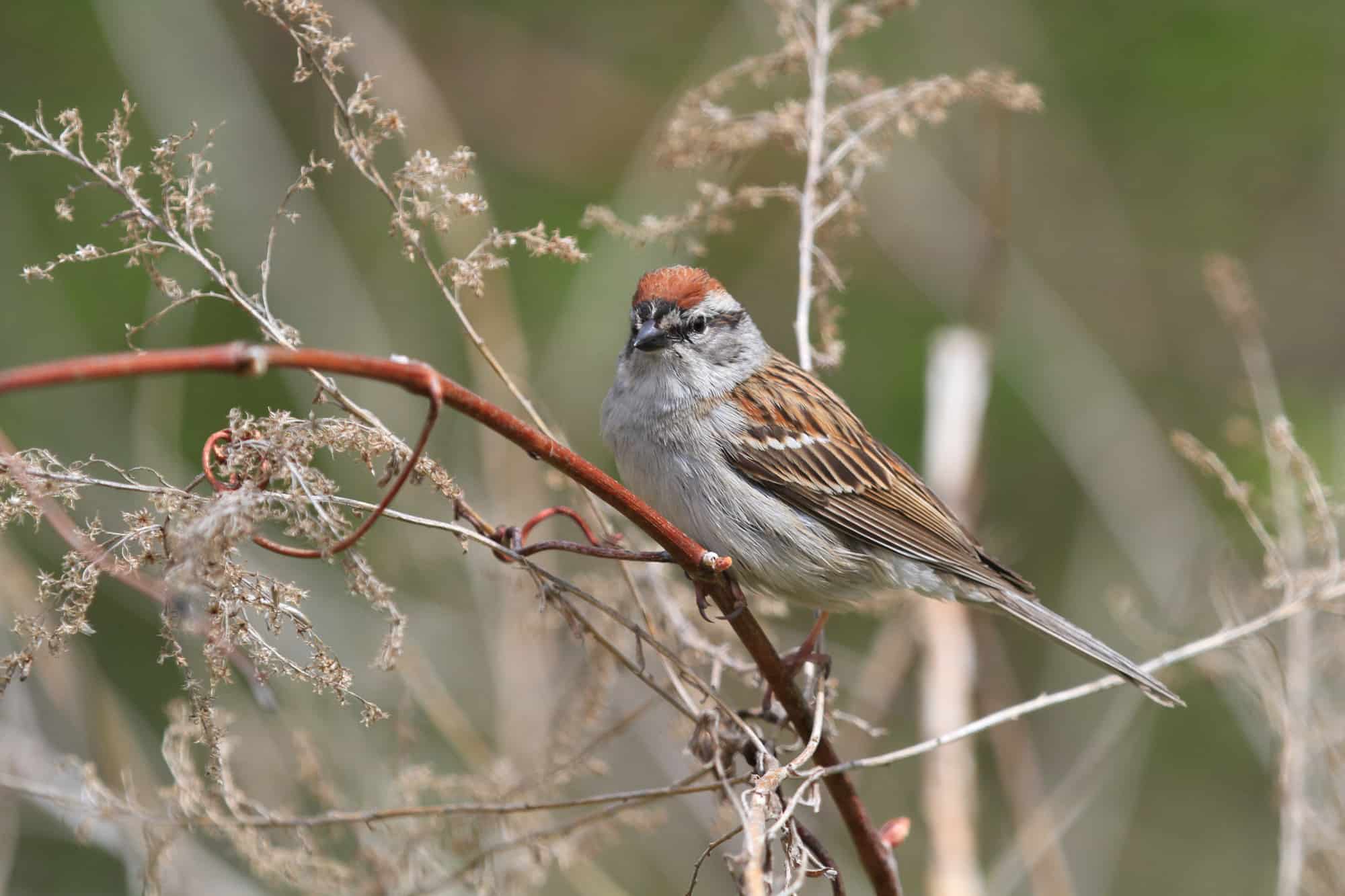
- Scientific Name: Spizella passerina
- Length: 4.7-5.9 in
- Weight: 0.4-0.7 oz
- Wingspan: 8.3 in
More of a classic small brown American sparrow than our first two species, chipping sparrows normally spend their time in small flocks (sometimes known as tournaments) in areas with plentiful trees. They get their name from their chipping, chirping calls which are so bright and cheerful.
Chipping sparrows are purely winter birds in Florida. Small numbers of them will breed in neighboring Alabama and Georgia, but most fly further north, even to Northern Canada and Alaska for the spring and summer nesting seasons.
If you’re a Florida local, you can attract chipping sparrows to your backyard during the winter with various kinds of bird food, such as black oil sunflower seeds, from seed hoppers and other kinds of bird feeders.
Savannah Sparrow
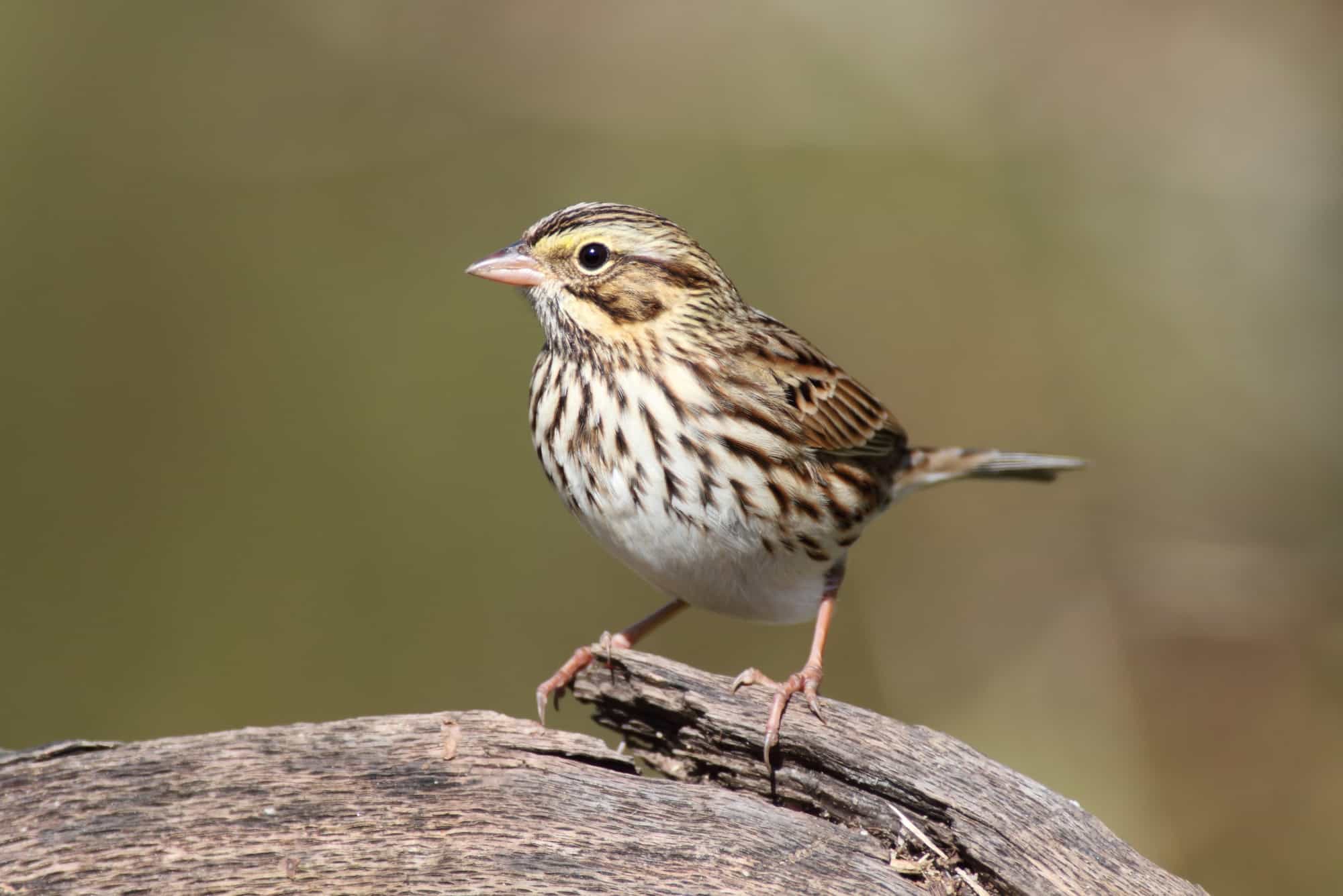
- Scientific Name: Passerculus sandwichensis
- Length: 4.3-5.9 in
- Weight: 0.5-1.0 oz
- Wingspan: 7.9-8.7 in
It can be difficult to distinguish savannah sparrows by sight from other similar species such as song sparrows. Only with a good pair of binoculars will you be able to spot its most defining characteristic – the subtle yellow streaks above its eyes.
As their name suggests, this sparrow species prefers spending its time out in the wilderness rather than in towns and cities, and won’t be tempted to garden bird feeders like many other beautiful sparrows are. Instead, this species feeds mainly on insects, which it can be seen chasing down either in short bursts of flight or on the ground.
Savannah sparrows are a relatively frequent sighting in the Florida countryside, but only during winter months. In the spring, they depart for the nesting grounds that extend north from the northern United States into the arctic circle.
Swamp Sparrow
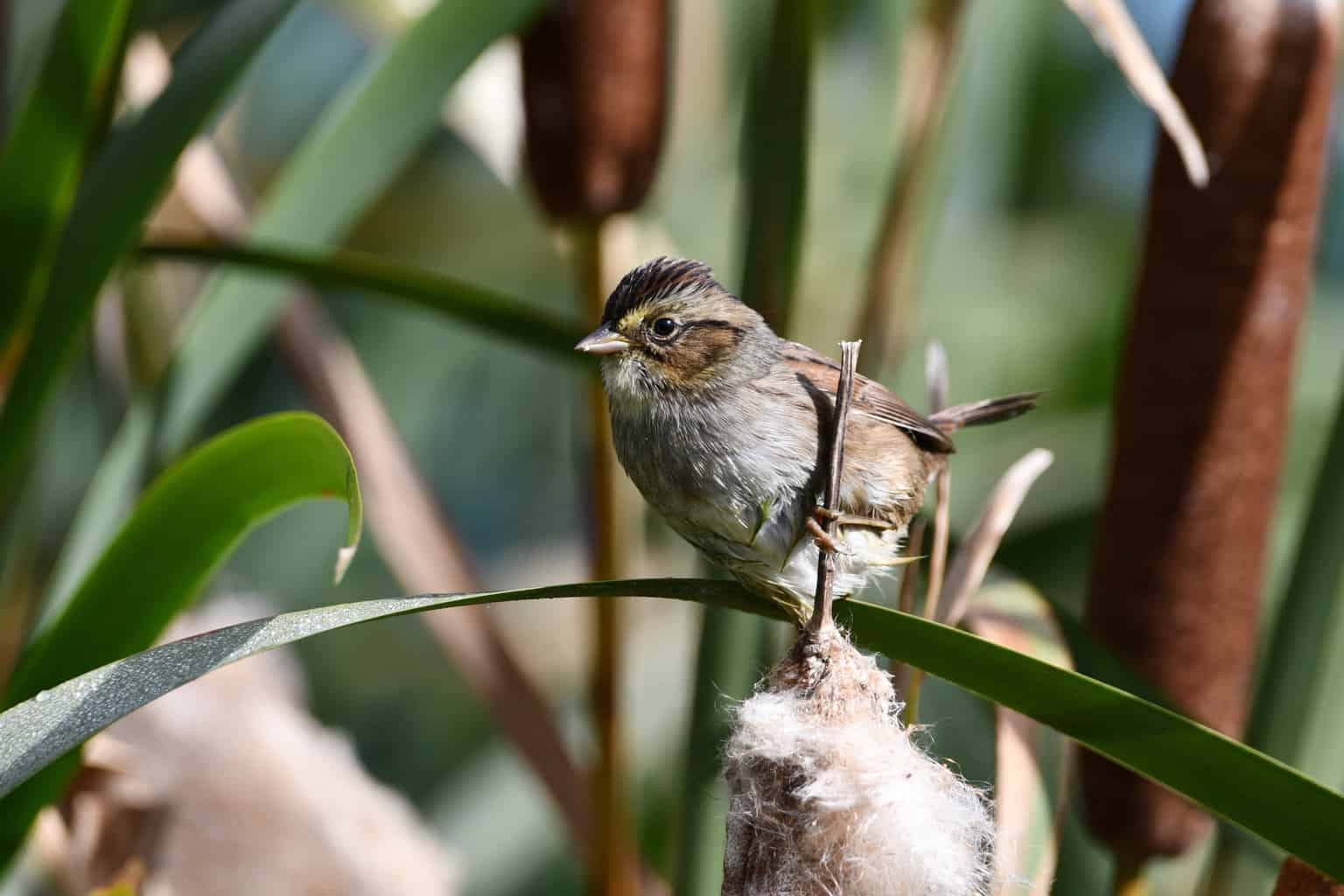
- Scientific Name: Melospiza georgiana
- Length: 4.7-5.9 in (12-15 cm)
- Weight: 0.5-0.8 oz (15-23 g)
- Wingspan: 7.1-7.5 in (18-19 cm)
Swamp sparrows are tiny birds that are most commonly seen around water. They’re famous for nesting in wetlands, coastal marshes, and bogs. As a secretive species, they can be difficult to spot and identify, but a few yellow feathers near their beaks can be seen with a pair of binoculars.
Despite their small size, the adorable swamp sparrow has a large migratory range that extends from Central America to Northern Canada. They can occasionally be persuaded to stop off in backyards by offering them a bird bath.
Swamp sparrows are strictly cold-season birds in Florida, where they can be found throughout the state in their favorite wild, water-side habitats.
Song Sparrow

- Scientific Name: Melospiza melodia
- Length: 4.7-6.7 in (12-17 cm)
- Weight: 0.4-1.9 oz (12-53 g)
- Wingspan: 7.1-9.4 in (18-24 cm)
The classic ‘little brown job’ of gardens and hedgerows, song sparrows are most easily identified by their voice. Their song becomes more and more constant in Florida over the winter, as these native birds prepare for their long voyage to their northerly breeding grounds.
While song sparrows are one of the most common sparrow species in much of the USA, they are much less numerous in the hot, humid climate of Florida. The southern tip of Florida is one of the very few places in the country where they can’t be found at all.
As opportunistic feeders, song sparrows will eat a vast variety of food items, including insects and worms, various grains, and even berries and small fruits. You can attract them to your backyard with a feeder, or by planting trees and shrubs that produce fruit for them to eat during autumn and winter.
Bachman’s Sparrow

- Scientific Name: Peucaea aestivalis
- Length: 4.9 – 6 in
- Weight: 0.6 -0.8 oz
- Wingspan: 6.9 – 7.5 in
Bachman’s sparrows are tiny brown birds that are solitary and secretive. As their brown and gray plumage camouflages perfectly into their shrubby forest habitats, this rare species should be considered a prized spotting.
Although they’re not common here, Florida is one of the strongholds of the Bachman’s sparrow, which is considered near threatened by the IUCN. It is thought that habitat loss is largely to blame for their demise.
Although absent in the southern tip of the state, Bachman’s sparrows are one of only three sparrow species that can be regularly found all year in Florida. They like to breed in open pine forests where they build domed nests hidden among long, dense grass or bushes.
White-throated Sparrow
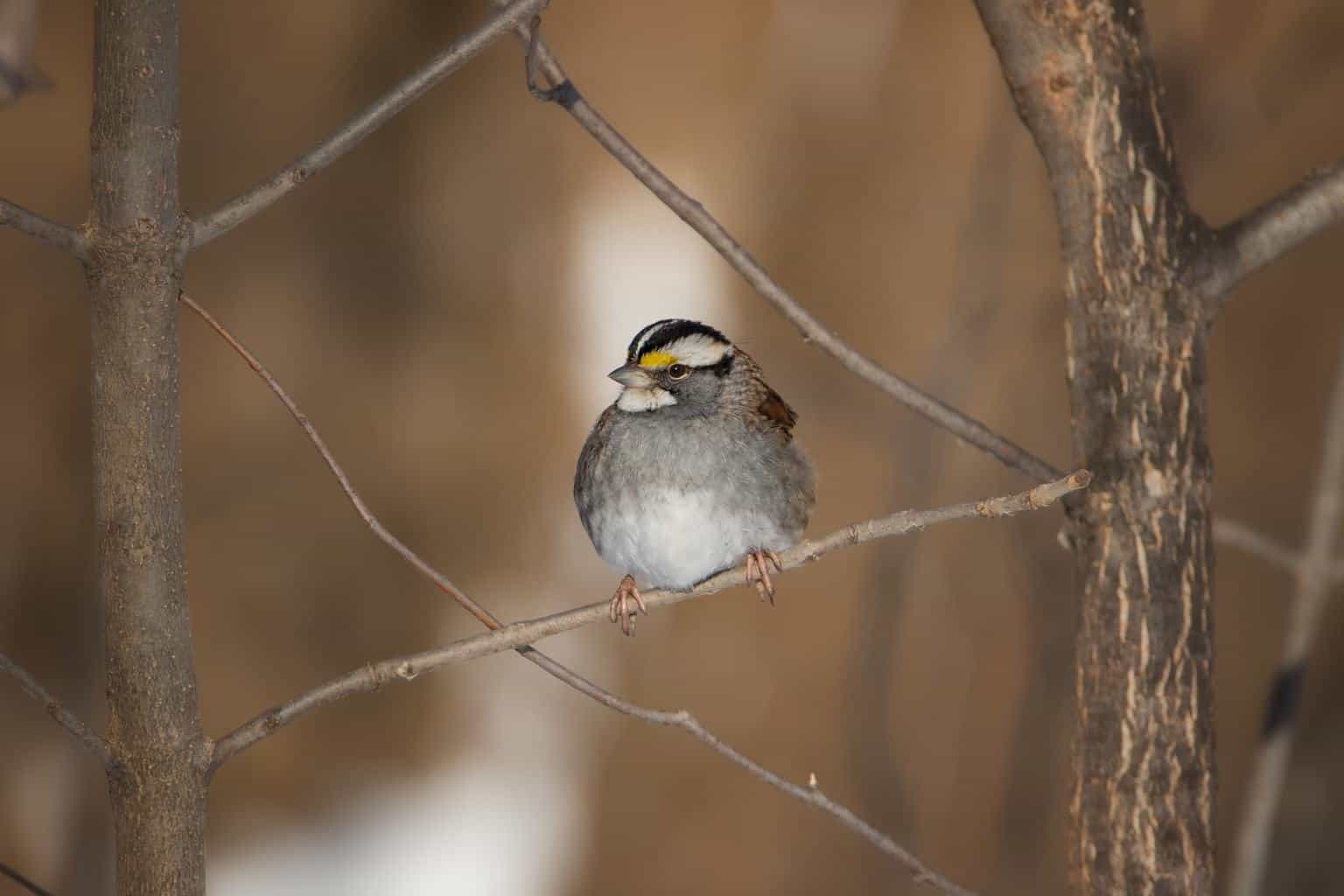
- Scientific Name: Zonotrichia albicollis
- Length: 6.3-7.1 in
- Weight: 0.8-1.1 oz
- Wingspan: 7.9-9.1 in
With their gorgeous black and white striped head and yellow eyebrows, these striking, medium-sized sparrows are quite easy to identify. Even if you don’t get a clear sighting of one, they are also easy to distinguish by their curious, mournful whistle.
While the white-throated sparrow is one of the most common sparrows in much of the Eastern USA, it is much rarer in Florida. These birds are only regularly seen in the northern quarter of the state during winter and are altogether absent during the summer.
Mostly eating seeds of various weeds and grasses, white-throated sparrows may also be attracted to gardens to nibble on autumn fruits, as well as to visit feeding stations during the winter.
Grasshopper Sparrow
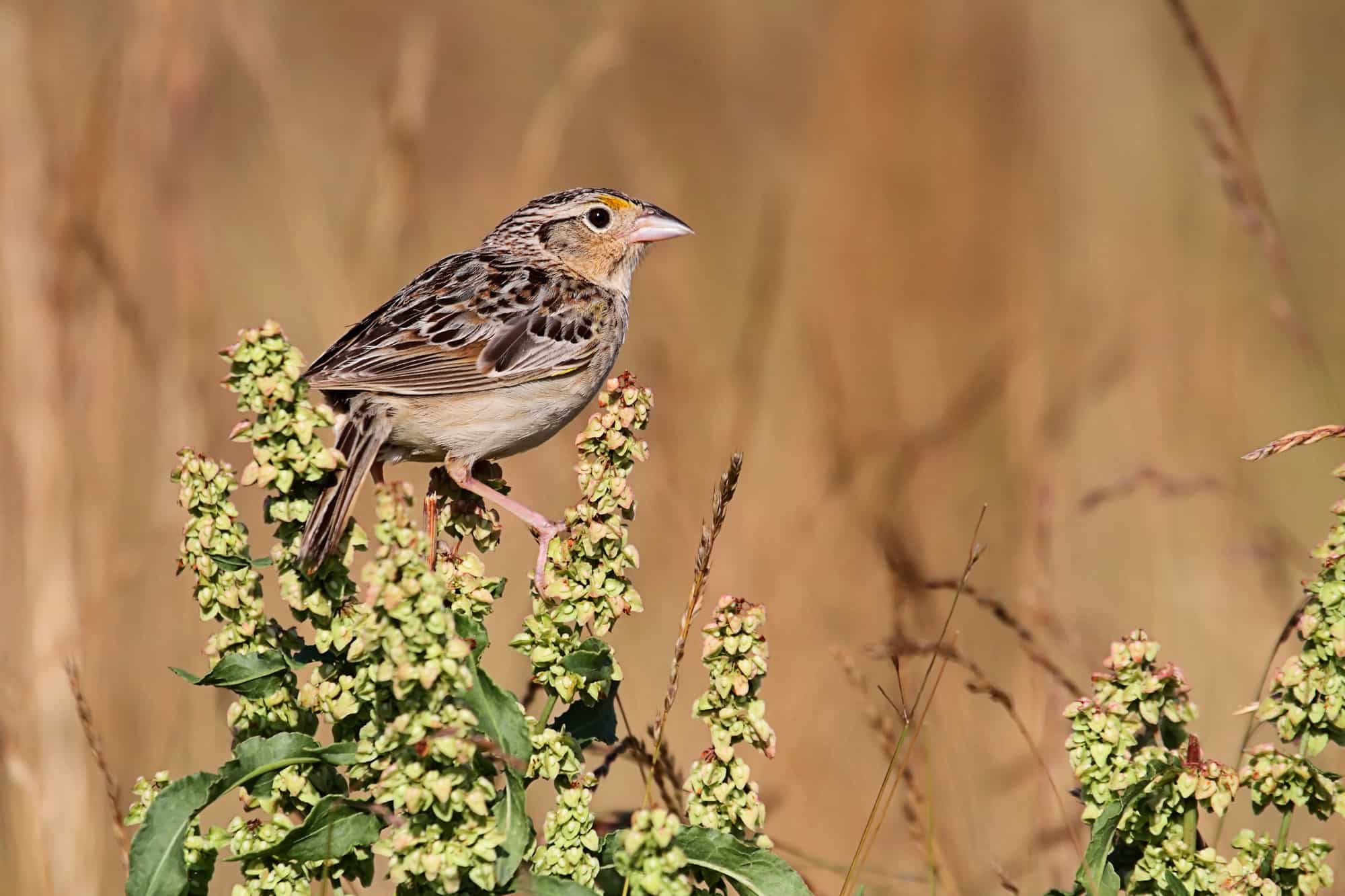
- Scientific Name: Ammodramus savannarum
- Length: 4.3-4.5 in (10.8-11.5 cm)
- Weight: 0.5-0.7 oz (14-20 g)
- Wingspan: 7.9 in (20 cm)
The grasshopper sparrow is a very notable bird species in Florida, and that’s because a local subspecies might be the rarest bird on the continent. The Florida Grasshopper Sparrow is endemic to the dry prairie ecosystem of central and south Florida, and can’t be seen anywhere else in the US.
As well as this subspecies, the regular species of grasshopper sparrow can be found throughout the state during the winter. But unlike the endangered subspecies, other grasshopper sparrows migrate to more northerly states for breeding in the summer.
Since 2019, captive breeding programs have been releasing hundreds of Florida grasshopper sparrows back out into the wild. This is no small contribution to a species that has been dangerously close to extinction due to prairie habitat loss over the last century.
You can find out more about the efforts to protect the Florida grasshopper sparrow on the Florida Fish and Wildlife Conservation Commission’s website.
Vesper Sparrow

- Scientific Name: Pooecetes gramineus
- Length: 5.1-6.3 in (13-16 cm)
- Weight: 0.7-1.0 oz (20-28 g)
- Wingspan: 9.4 in (24 cm)
Vesper sparrows are closely related to lark sparrows, which are even rarer species in Florida. One of the ways you can tell them apart from their cousin is the flash of white feathers that are seen during flight.
These medium-large sparrows are only normally present in the northern half of Florida during the winter months. They are never a common sight in the Eastern United States, however, and their numbers have been declining across North America.
Modern agricultural practices are thought to be partly to blame for its demise since this sparrow requires grasslands with high biodiversity to thrive. Conservation efforts will be critical to prevent populations from declining even further.
White-crowned Sparrow

- Scientific Name: Zonotrichia leucophrys
- Length: 5.9-6.3 in (15-16 cm)
- Weight: 0.9-1.0 oz (25-28 g)
- Wingspan: 8.3-9.4 in (21-24 cm)
The white-crowned sparrow is fairly easy to recognize by their black-and-white striped head and orange-pink bill.
This largish sparrow is one of the most common winter sparrows in several states, but not in Florida. They are only normally seen in the north of the state, and even here they can’t be seen every day.
If you do spot white-crowned sparrows in Florida, you may see them grouped in large flocks, moving over weedy and brushy areas. Northern Florida residents may also be able to attract them to their backyards by offering them a variety of seeds, millet, and other types of bird food.
Field Sparrow

- Scientific Name: Spizella pusilla
- Length: 4.7-5.9 in (12-15 cm)
- Weight: 0.4-0.5 oz (11-15 g)
- Wingspan: 7.9 in (20 cm)
Field sparrows are a close cousin of the chipping sparrow, but are slightly larger, with a longer tail and a slightly orange hue. A good way to identify this shy bird is by its series of high-pitched trills that sound a bit like a bouncing ball coming to a stop!
Field sparrows have a limited geographical range that’s almost exclusively within the Central and Eastern United States. These small birds can only be seen in Florida during the winter, except for a very small nesting population along the border with Alabama and Georgia.
As their name suggests, field sparrows prefer life out in the meadows to areas nearby human habitation, and their reclusive nature can make them difficult to spot. Sadly, their numbers are declining due to the loss of the wildflower meadow habitat that they rely on for sustenance.
Seaside Sparrow
- Scientific Name: Ammospiza maritimus
- Length: 5.1-5.9 in
- Weight: 0.7-1.0 oz
- Wingspan: 7.1-7.9 in
The seaside sparrow can be told apart from its cousins the saltmarsh sparrow and Nelson’s sparrow by its larger, stockier build, small yellow ‘eyebrow’, and clean white throat.
Whereas the salt marsh sparrow is more common on the eastern coast of Florida, the seaside sparrow is seen more frequently in the west, where they can be seen year-round.
Salt marshes are the favorite haunt of the seaside sparrow, where it will use its long, stout bill to dig in the mud for sea creatures as well as feed on terrestrial insects, spiders, and their favorite seeds.
Nelson’s Sparrow
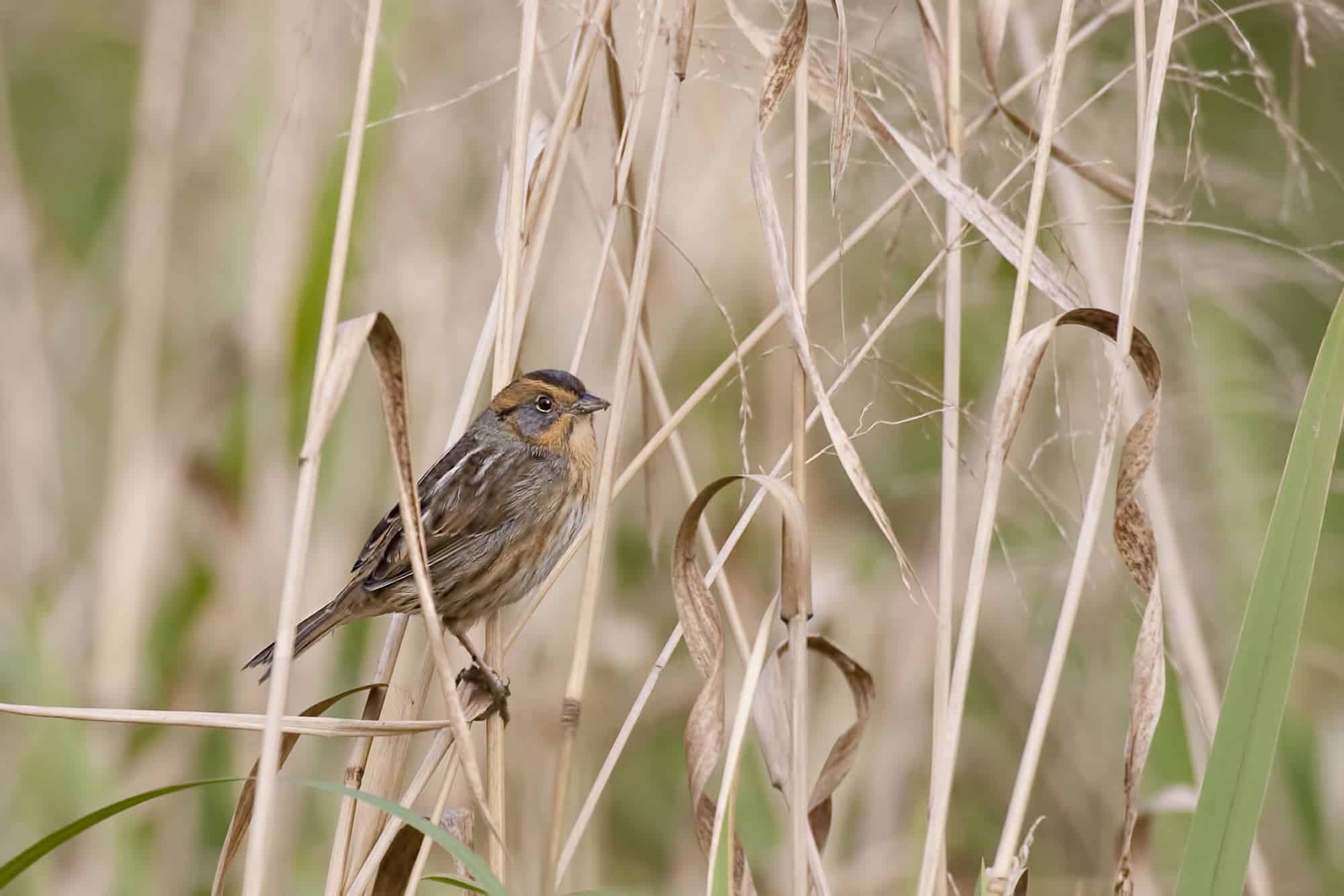
- Scientific Name: Ammospiza nelsoni
- Length: 4.3-5.1 in (11-13 cm)
- Weight: 0.6-0.7 oz (17-21 g)
- Wingspan: 6.5-7.9 in (16.5-20 cm)
Nelson’s sparrows are very similar to salt marsh sparrows and were thought to be the same species until 1989! These two species differ from the similar LeConte’s sparrow with their slightly longer bill, darker overall color, and often different habitat preferences.
Now known to be distinct, Nelson’s sparrow’s distribution map had to be redrawn. One of the places that this mysterious species overwinters is the coastline of Florida. They can be found in all coastal areas here except in the very south of the state.
Like their cousins, they rely mainly on salt marshes to provide insects and mollusks as their main source of food. They often sing at night with a curious, hiss-like call.
Lincoln’s Sparrow

- Scientific Name: Melospiza lincolnii
- Length: 5.1-5.9 in
- Weight: 0.6-0.7 oz
- Wingspan: 7.5-8.7 in
The best way to identify Lincoln’s sparrow is to learn its song. Quite distinct from its cousins the song sparrow and swamp sparrow, Lincoln’s sparrow produces a lively, tuneful, gurgling song that must be one of the sweetest of any songbird in North America.
Another species that loves marshy habitats, Lincoln’s sparrow is more commonly found further north but only makes an occasional appearance in Florida. Although it’s possible to see them throughout the entire state, your chances are slim – they’re only seen by about one in a thousand bird watchers here!
Scientists still have much to learn about Lincoln’s sparrows which is a testament to how hard this species is to observe!
Saltmarsh Sparrow

- Scientific Name: Ammospiza caudacuta
- Length: 4.7-5.1 in (12-13 cm)
- Weight: 0.6-0.8 oz (17.1-24.1 g)
- Wingspan: 6.5-7.7 in (16.5-19.5 cm)
Like their cousin, the seaside sparrow, the saltmarsh sparrow is a small bird that can be found along the east coast of North America. They can be told apart from their relatives by the orange feathers on their faces.
To spot saltmarsh sparrows, your best chance is to look over coastal mud flats during low tide when these birds will scour the soil, looking for insects and other creatures that have been exposed by the receding tidal water.
The west coast of Florida is only an occasional winter habitat for this migratory sparrow. For the spring and summer, they fly to the coastal areas of the Northeastern United States and Southeastern Canada.
Very Rare Sparrows in Florida
According to statistics on ebird.org, the sparrow species listed above have all been seen by at least one in a thousand bird watchers in Florida. But there are several even rarer sparrow species here that we haven’t covered yet!
Dark-eyed Junco (Junco hyemalis)
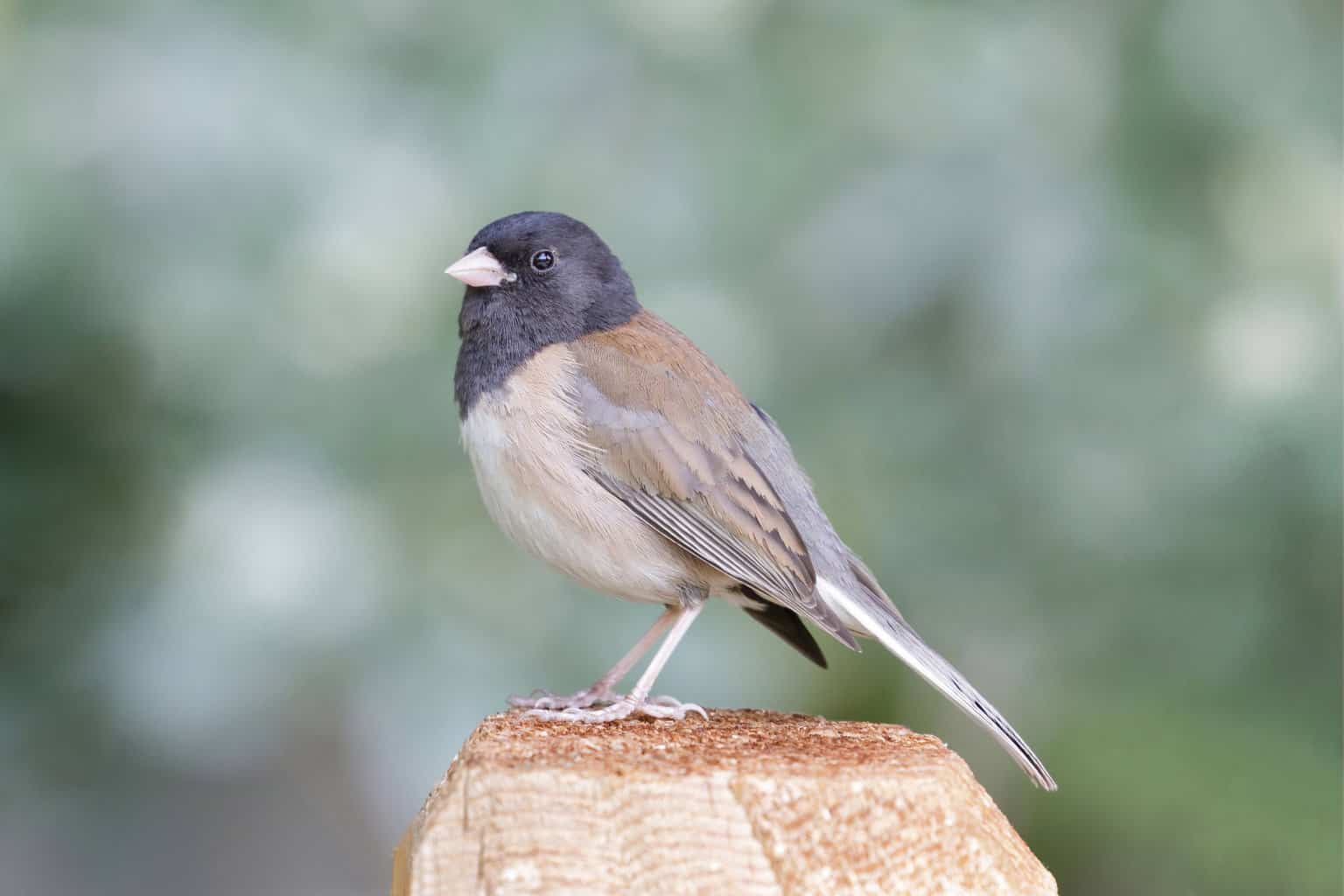
Despite being one of the most common and ubiquitous sparrows across North America, the dark-eyed junco should be considered a prized sighting in Florida. The slate-colored subspecies can only be seen in the north of the state, and even there, they are rare.
Fox Sparrow (Passerella iliaca)

Fox sparrows are also a much more common species further north but rarely venture into Florida. As one of the largest sparrow species with a speckled chest, you could even mistake them for a small thrush!
Henslow’s Sparrow (Centronyx henslowii)
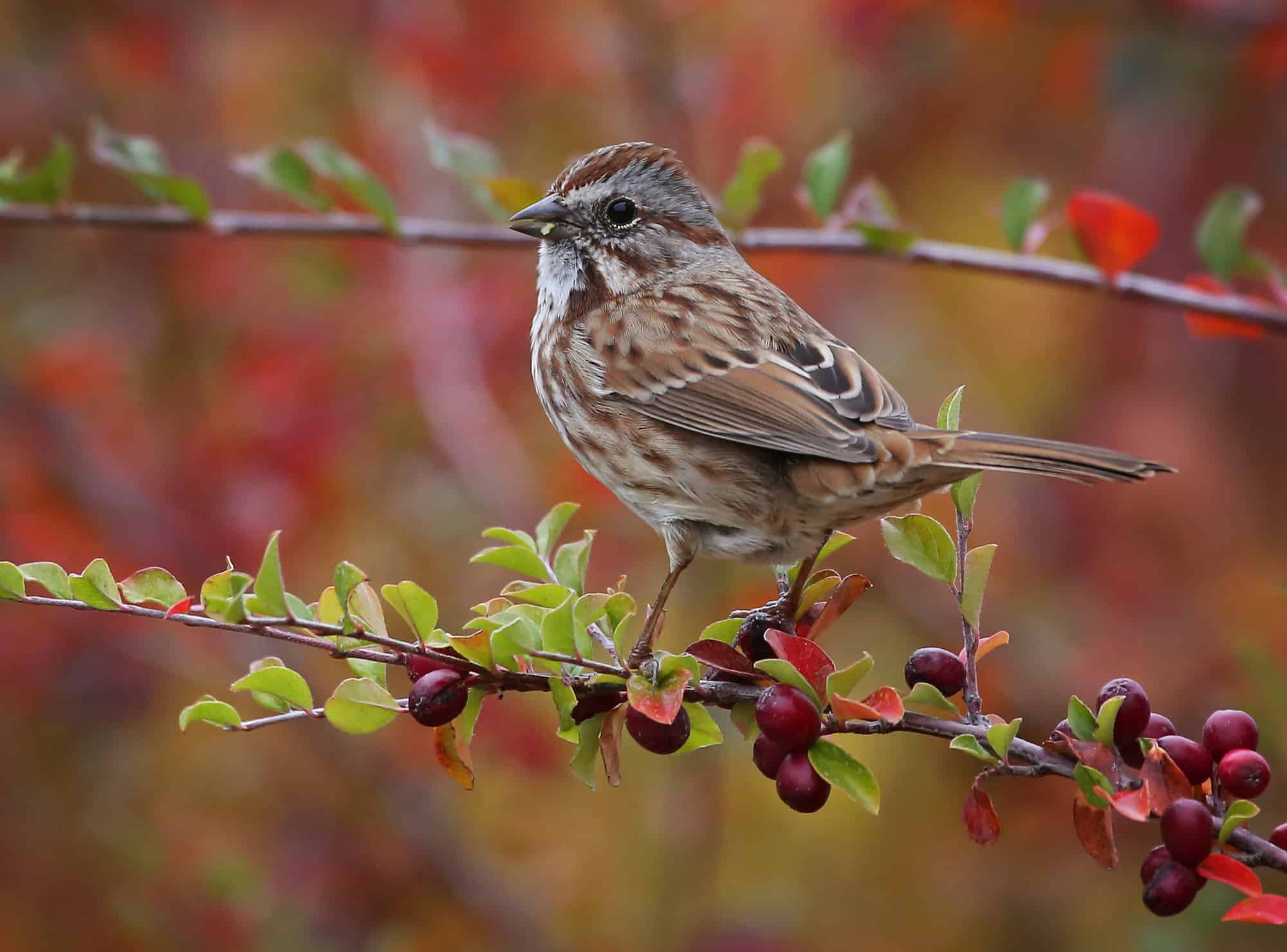
Henslow’s sparrows are typically rare sparrows that suffered a dramatic decline across their southeastern territories due to habitat loss. Their numbers are now stabilizing, thanks in part to the Conservation Reserve Program implemented by the United States Department of Agriculture.
LeConte’s Sparrow (Ammospiza leconteii)

A close cousin of Henslow’s sparrow, LeConte’s sparrow is slightly more widespread but certainly not a common sparrow species anywhere in the US. They prefer wet grassland habitats which have been declining due to agricultural land drainage schemes.
Lark Sparrow (Chondestes grammacus)
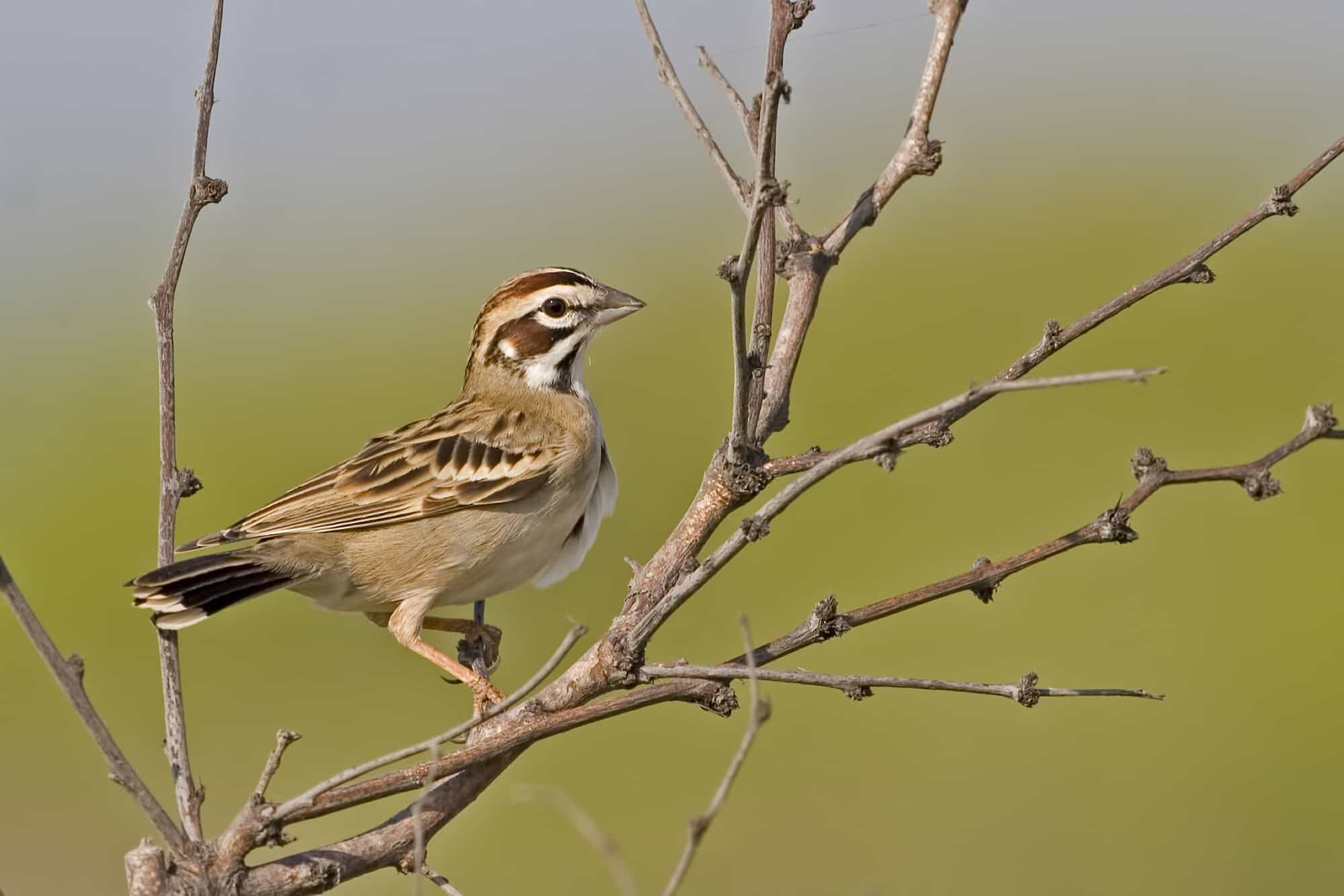
Lark sparrows are seldom seen in Florida, but they occasionally are seen wandering here from their usual territories further west. Your best chances of seeing them are in open, grassy areas in the northwest of the state.
Java Sparrow (Padda oryzivora)
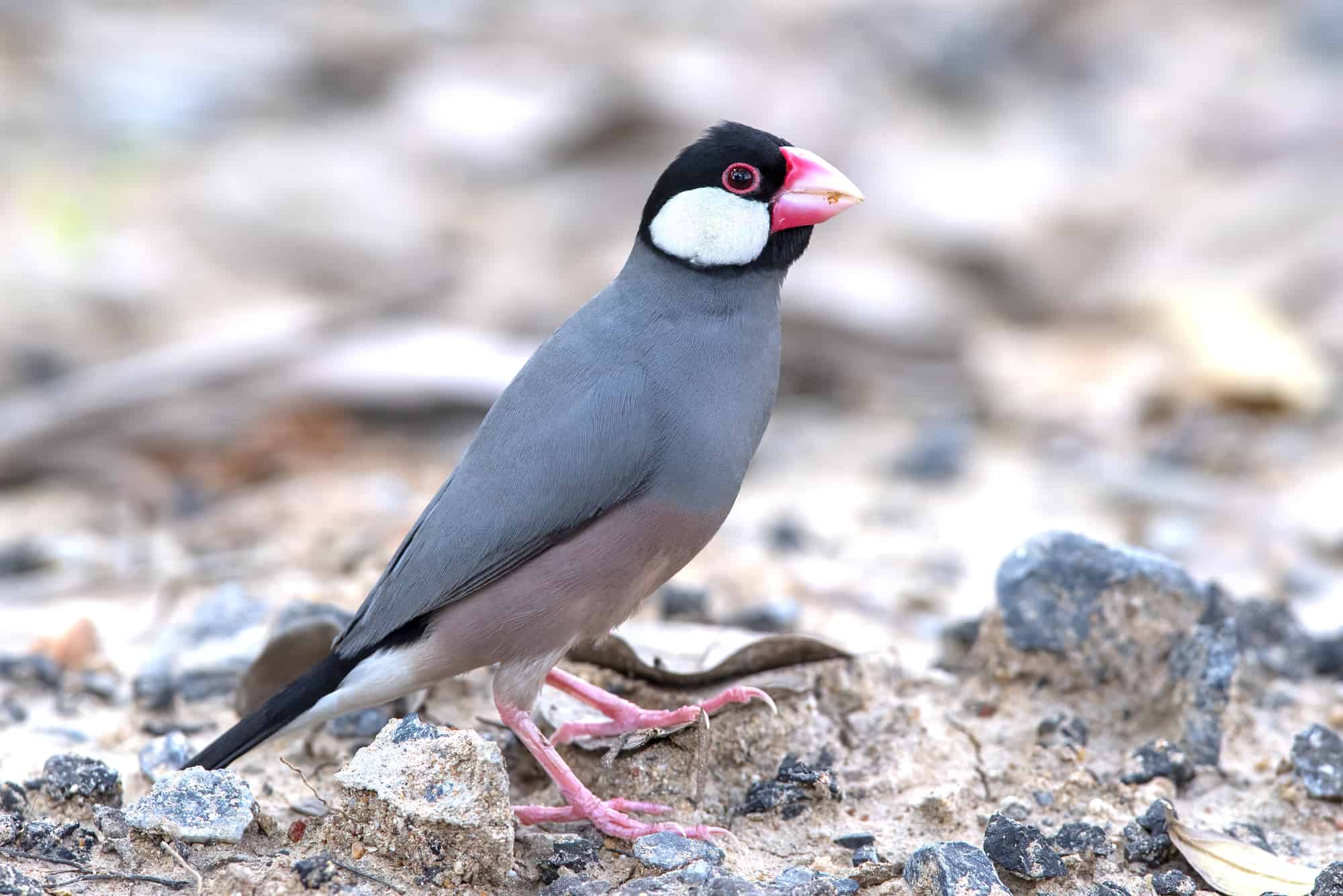
Not really a sparrow but an exotic type of finch, Java sparrows are kept as pets across North America. Since Florida is one of the few states that’s warm enough for escaped Java sparrows to survive outside, you might see them here and do a double-take!
Conclusion
Florida has its fair share of sparrow species but many of them are very rare. Sadly their dwindling populations are often due to human development.
To restore sparrow populations to their former glory, we need to work hard to restore their natural habitats. The American Bird Conservancy (ABC) is doing great work to make that happen, and you can find out more about their work with sparrows here.
The tropical and subtropical climates of Florida make it a popular destination for many birds and bird watchers alike! To learn more about the exotic birds you can see here, don’t miss our dedicated guide to 26 glorious birds in The Sunshine State.

